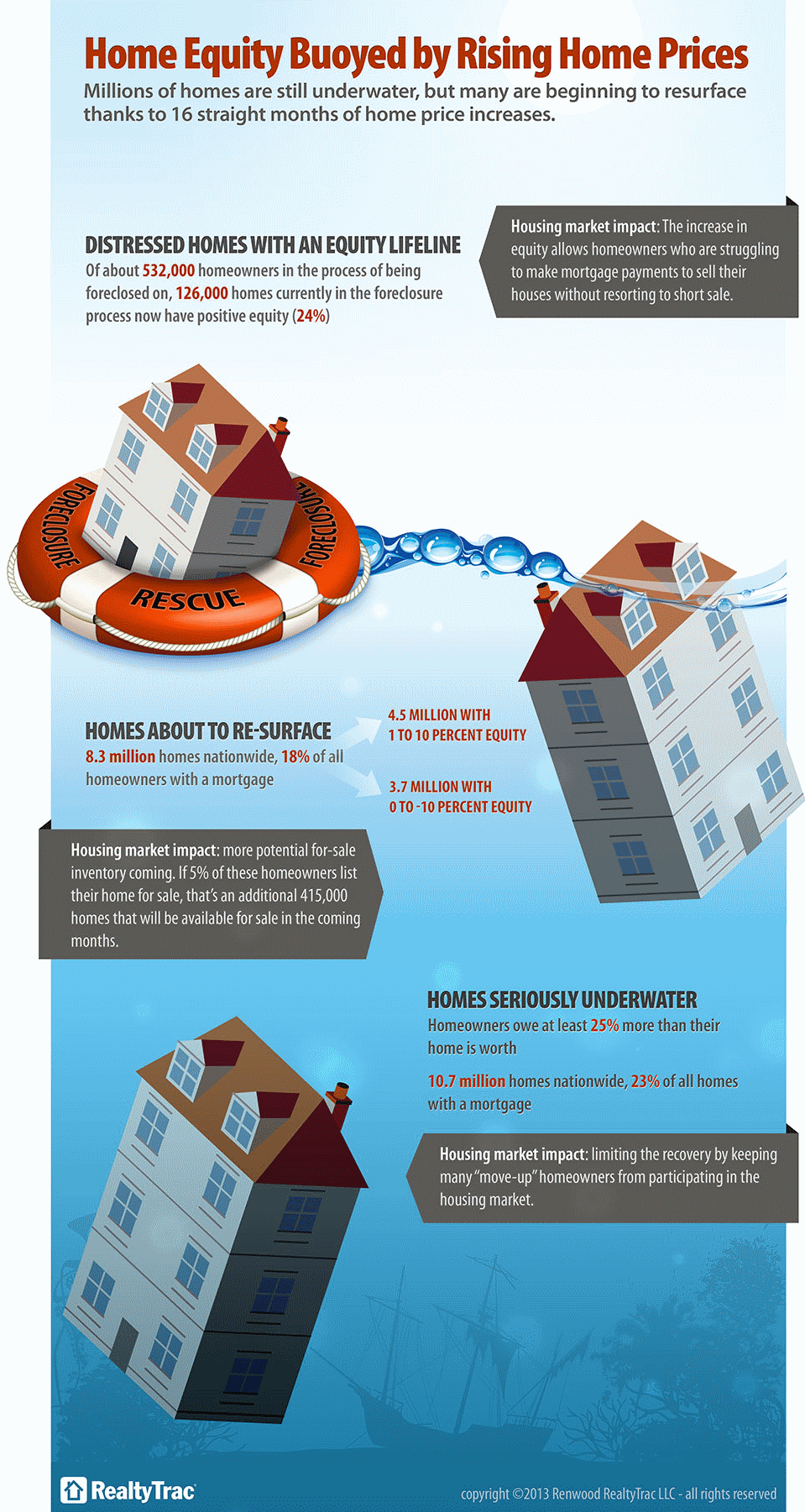Blog

Rising Prices Lifting all Boats but Millions still Submerged
Almost a quarter of U.S. homeowners withrna mortgage are still underwater after the rapid plunge of house prices thatrnstarted in 2007, however more and more of those homeowners are seeing their equityrnreturn RealtyTrac said today. Homernprices, which finally began to rise early last year, have pulled an estimatedrn600,000 properties from the category of “deeply underwater” just since May.</p
At that time about 26 percent of mortgagedrnhomes had a loan to value (LTV) ratio of 125 percent or more; that is about 11.3rnmillion homes were deeply underwater. rnRealtyTrac estimates that number at 10.7 million now, 23 percent. In September 2012 there were an estimatedrn12.5 million such homeowners, 28 percent of those with a mortgage.</p
Therncompany says another 8.3 million homeowners have what it calls “resurfacingrnequity,” meaning they had between 10 percent negative and 10 percent positivernequity at the beginning of September. rnThis is about 18 percent of all homeowners with a mortgage. These owners, the company says, are on trackrnto have enough equity to sell their home sometimes in the next 15 monthsrnwithout resorting to a short sale. Despiternwhat has happened to prices over the last seven years RealtyTrac estimates thatrn7.4 million homeowners, 16 percent of those with a mortgage, have 50 percent orrnmore equity in their homes. </p
 </p
</p
“Steadily rising home prices arernlifting all boats in this housing market and should spill over into morerninventory of homes for sale in the coming months,” said Daren Blomquist, therncompany’s vice president. “Homeownersrnwho already have ample equity are quickly building on that equity, while thern8.3 million homeowners on the fence with little or no equity are on track tornregain enough equity to sell before 2015 if home prices continue to increase atrnthe rate of 1.33 percent per month that they have since bottoming out in Marchrn2012.” </p
The report says that 126,000rnproperties, about a quarter of those currently in foreclosure, had LTVs belowrn100 percent in September, about 24 percent of the total. This was higher in several states includingrnOklahoma (54 percent), Hawaii (51 percent), New York (47 percent), and Texasrn(46 percent).</p
Blomquist said that homeowners inrnforeclosure with some equity have a better chance to avoid foreclosure withoutrnresorting to a short sale assuming they don’t miss the opportunity to leveragernthat equity. “Even homeowners deeplyrnunderwater have reason for hope, with about 150,000 each month rising past thern25 percent negative equity milestone – although it will certainly take yearsrnrather than months before most of those homeowners have enough equity to sell</bother than via short sale."</p
States with the highest percentage of homesrnwith LTVs of 125 percent or higher included Nevada (46 percent), Illinois (40rnpercent), Florida (40 percent), Michigan (38 percent), Rhode Island (34rnpercent), and Ohio (31 percent).</p
Metro markets with the highest percentage ofrnhomes with resurfacing included Omaha (29 percent), Colorado Springs (29rnpercent), Tulsa (29 percent), Little Rock (28 percent), and Raleigh (28rnpercent).
All Content Copyright © 2003 – 2009 Brown House Media, Inc. All Rights Reserved.nReproduction in any form without permission of MortgageNewsDaily.com is prohibited.
Latest Articles
By John Gittelsohn August 24, 2020, 4:00 AM PDT Some of the largest real estate investors are walking away from Read More...
Late-Stage Delinquencies are SurgingAug 21 2020, 11:59AM Like the report from Black Knight earlier today, the second quarter National Delinquency Survey from the Read More...
Published by the Federal Reserve Bank of San FranciscoIt was recently published by the Federal Reserve Bank of San Francisco, which is about as official as you can Read More...

Comments
Leave a Comment